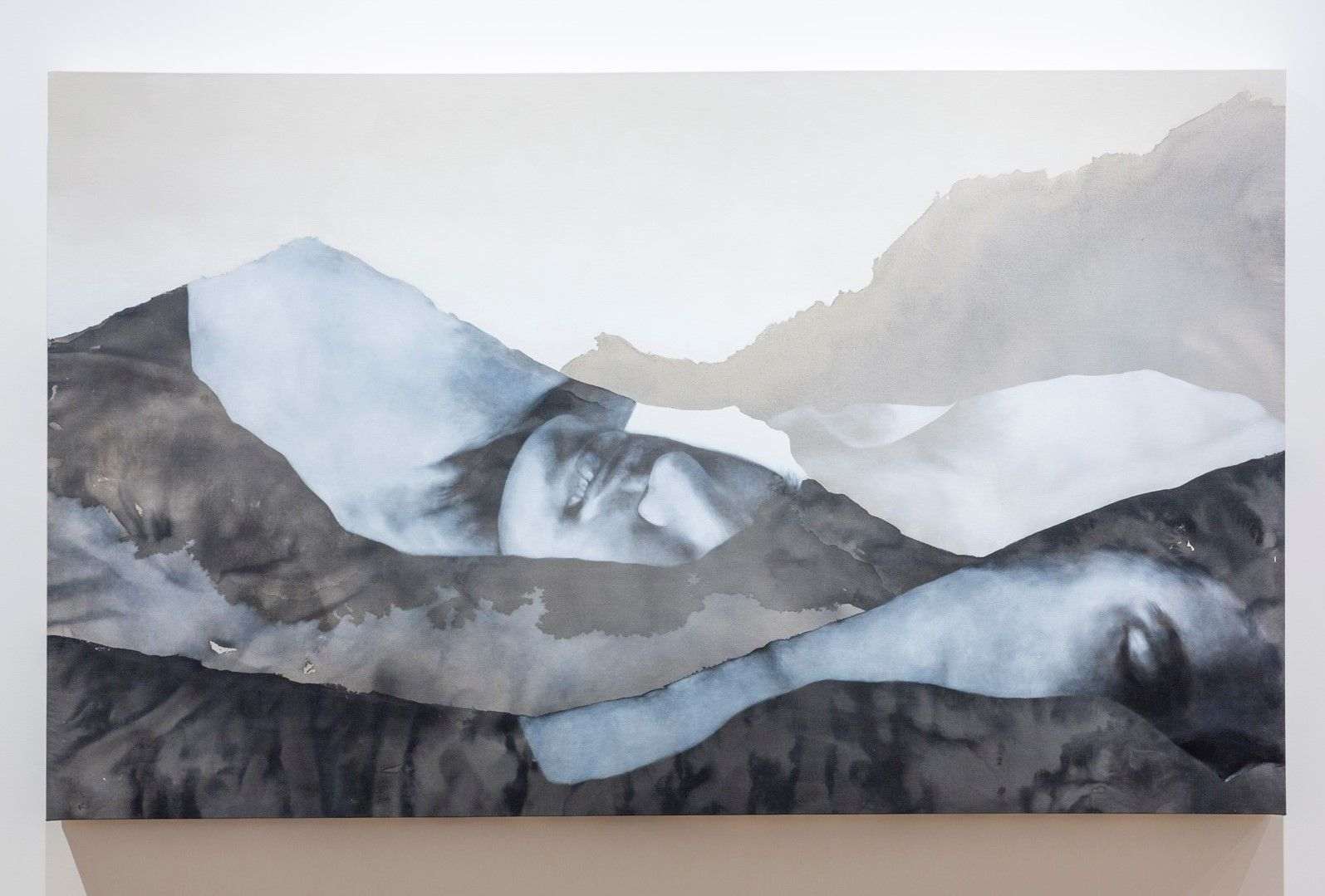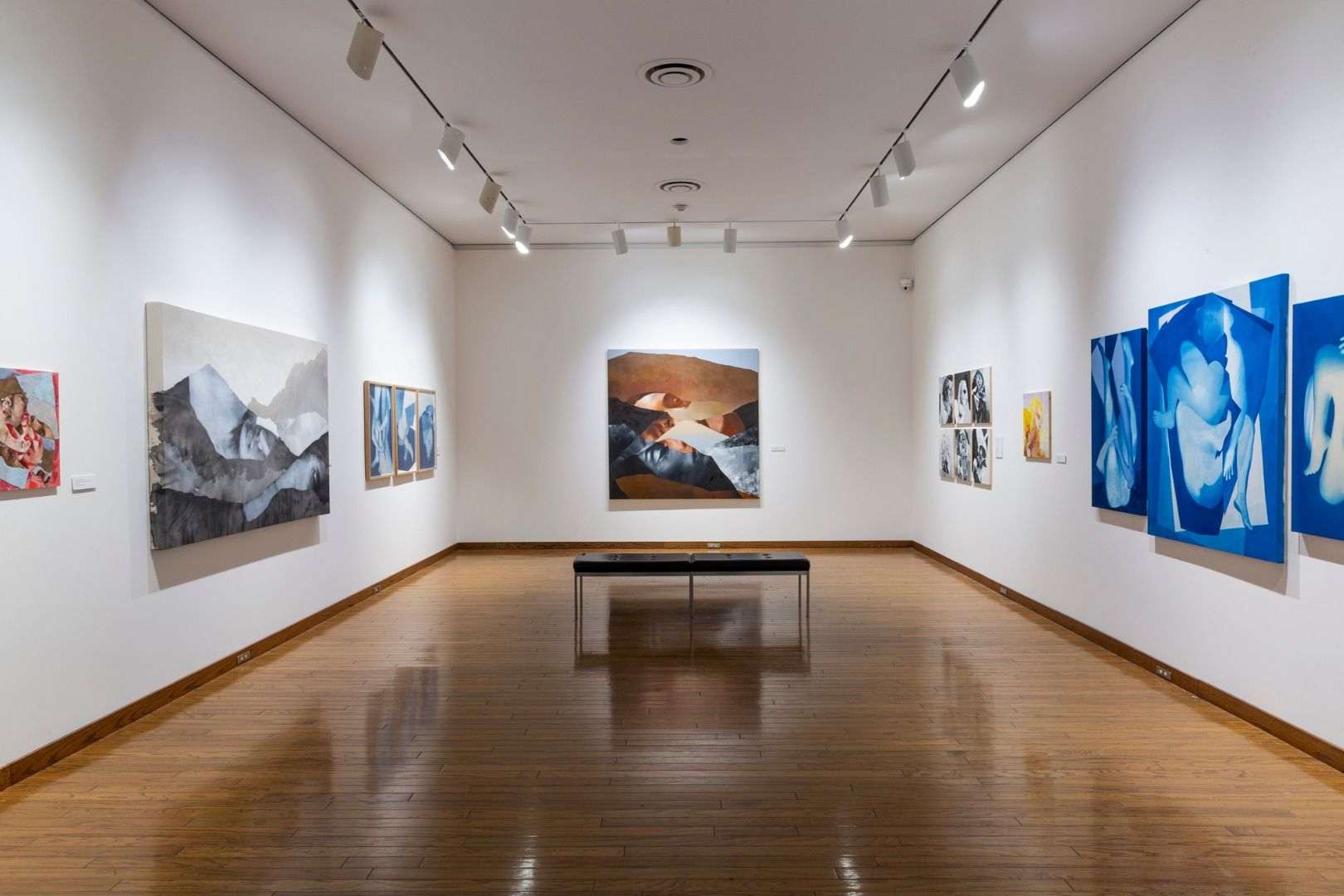Lacey McKinney: Reconfiguration is currently on view at the Everson. In her paintings, collages, and cyanotypes, McKinney explores the power of images to construct—and subvert—identity. Her work draws upon the theories of embodiment and feminism, but is firmly grounded in current conversations about gender norms and social hierarchies. McKinney sources images from mass media, history books, and her own photographs which she then uses to create new works. Her portraits of women and depictions of the female body challenge the history of the portraiture genre, contemplate the physical spaces bodies occupy, and question how bodies relate to one another.
McKinney recently took some time to answer five questions about her work.
1. Reconfiguration is both the title of the exhibition and the title for all of the works included in the show. What does that term mean, in relation to your work?
The title describes the process of searching through a plethora of different possibilities. Collage is a medium with reconfiguration at its core, carrying a rich history of challenging problematic social practices through the disruption of images. For me, moving through various corporeal arrangements is a reckoning with value systems. In other words, each work is a marker of slowly coming to terms with existing in this ugly, beautiful scaffolding in which we live.
2. What discussions do you hope your work generates?
My intention is to traverse my interests in culture: identifying beliefs, how they take form, how they shape us and manifest as physical things. I know people who just want to be artists, rather than “women artists,” free to just make whatever they want without the obstacle and burden it entails. I find it difficult to escape the entrapments of gender, so that remains a point of contention in my work, a constant that I grapple with, something that sparks wonder and intense curiosity. That is quite specific, but I think other associations can organically expand with viewers in relation to their own interests and experiences. I love that aspect of art, its ability to connect people to embody so many different things for different people.
3. What does an average day in the studio look like for you?
I like to get up early and go straight to the studio after breakfast to create momentum that then influences the entire day. Because my studio is in my house, it saves time and I can get right to work. I listen to podcasts and audio books while I work, and sometimes music if I need to get energized. I take a break for lunch and then go right back to work. I try not to look at emails or social media on scheduled studio days because it will lead me on a non-studio work tangent and sap my creative energy. I make dinner at the end of the day. Sometimes I’ll decompress at night or work for a bit more and then I’ll go to bed relatively early.
4. Your exhibition at the Everson was delayed by, then opened in the midst of the Covid-19 pandemic. Has the pandemic changed your artistic practice in any way, and did it impact the work shown in the exhibition?
The circumstances of the pandemic provided more solitude, which I needed to produce. In that sense, maybe I was a bit more productive in the studio. I think the extra time allowed me to switch gears a bit and experiment with different media. That’s how cyanotype collages appeared in the exhibition. Despite the suffering we are going through, there are also silver linings. The newly embraced technology of meeting virtually can save a lot of time and energy that can be reallocated to other tasks. I’m appreciative that I can attend art talks and events that normally I may not have access to if they required extensive travel. The decrease in carbon emissions as a result of less commuters also has me thinking about how environmental implications relate to ideas I’ve thought about previously in my practice.
5. What are you working on now, or what plans do you have for the future?
I’m now working on silver gelatin photograms, which are a continuation of the cyanotypes in the exhibition. Winter time in New York is not conducive for UV exposure, so I’m working in the darkroom instead. I intend to use more analog alternative photographic methods as I continue in the studio. I’m looking forward to summer when I can use the sun again as a means of exposure.
This March, I’ll be participating in a group exhibition virtually on Artsy as well as physically at Urban Zen in New York City, a philanthropic initiative by the fashion designer Donna Karan. The show is curated by Mashonda Tifrere and titled Truth About Me. It launches on International Women’s Day and features virtual conversations with artists and panels including speakers from the Whitney Museum, Brooklyn Museum, and Artsy. In addition, I’m looking forward to a two-person show at the University of North Carolina at Charlotte, slated for fall 2021, with my friend and fellow artist Jon Verney titled Metamorphosis.
Lacey McKinney: Reconfiguration is on view through February 28, 2021. To learn more about McKinney’s work, watch the virtual studio visit below.
—Steffi Chappell, Assistant Curator
Image captions:
- Installation photograph of Lacey McKinney: Reconfiguration, on view at the Everson November 14, 2020 – February 28, 2021. Photo credit: Jamie Young.
- Lacey McKinney, Reconfiguration 29, 2020, oil and acrylic on canvas, 51 x 48 inches, courtesy of the artist. Photo credit: Jamie Young.
- Lacey McKinney, Reconfiguration 43, 37, and 49, 2020, cyanotype on muslin, 33 x 24 inches each, courtesy of the artist. Photo credit: Jamie Young.




